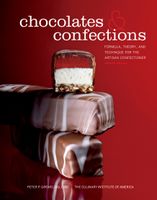Label
All
0
Clear all filters
🔥 Celebrate new books on our BBQ & Grilling shelf with 25% off ckbk membership 🔥
Marshmallow
Appears in
By Peter Greweling and Culinary Institute of America
Published 2007
Marshmallow has a long history. Most food historians place its origin in ancient Egypt, where the mucilaginous sap from the root of the marshmallow plant was mixed with honey to create this confection. Marshmallow made in this period was reserved for royalty, for use as a salubrious dietary supplement or as a respiratory curative. Today’s marshmallow is a far cry from this early concoction. Modern marshmallow is made using sugar, glucose syrup, gelatin, and flavoring. Some marshmallow products are made using albumen as the sole aerator, and some are made using both albumen and gelatin. As opposed to the extruded cylindrical mass-produced marshmallows, artisan marshmallows are spread into a slab, allowed to set, and cut with either a wire cutter or a knife. Marshmallows formed in slabs may be either enrobed in chocolate or lightly dredged in starch and consumed without enrobing. The most common marshmallows are uncrystallized, but grained, or crystallized, marshmallows are also made. These confections contain less glucose syrup, and after they are aerated they are seeded with confectioners’ sugar to induce crystallization. Grained marshmallows have a shorter texture than those that are ungrained.
Become a Premium Member to access this page
Unlimited, ad-free access to hundreds of the world’s best cookbooks
Over 150,000 recipes with thousands more added every month
Recommended by leading chefs and food writers
Powerful search filters to match your tastes
Create collections and add reviews or private notes to any recipe
Swipe to browse each cookbook from cover-to-cover
Manage your subscription via the My Membership page
Best value
Part of
Advertisement
Related Recipes
-
-
-
-
Related Reference
-
-
-
-
Advertisement
The licensor does not allow printing of this title




